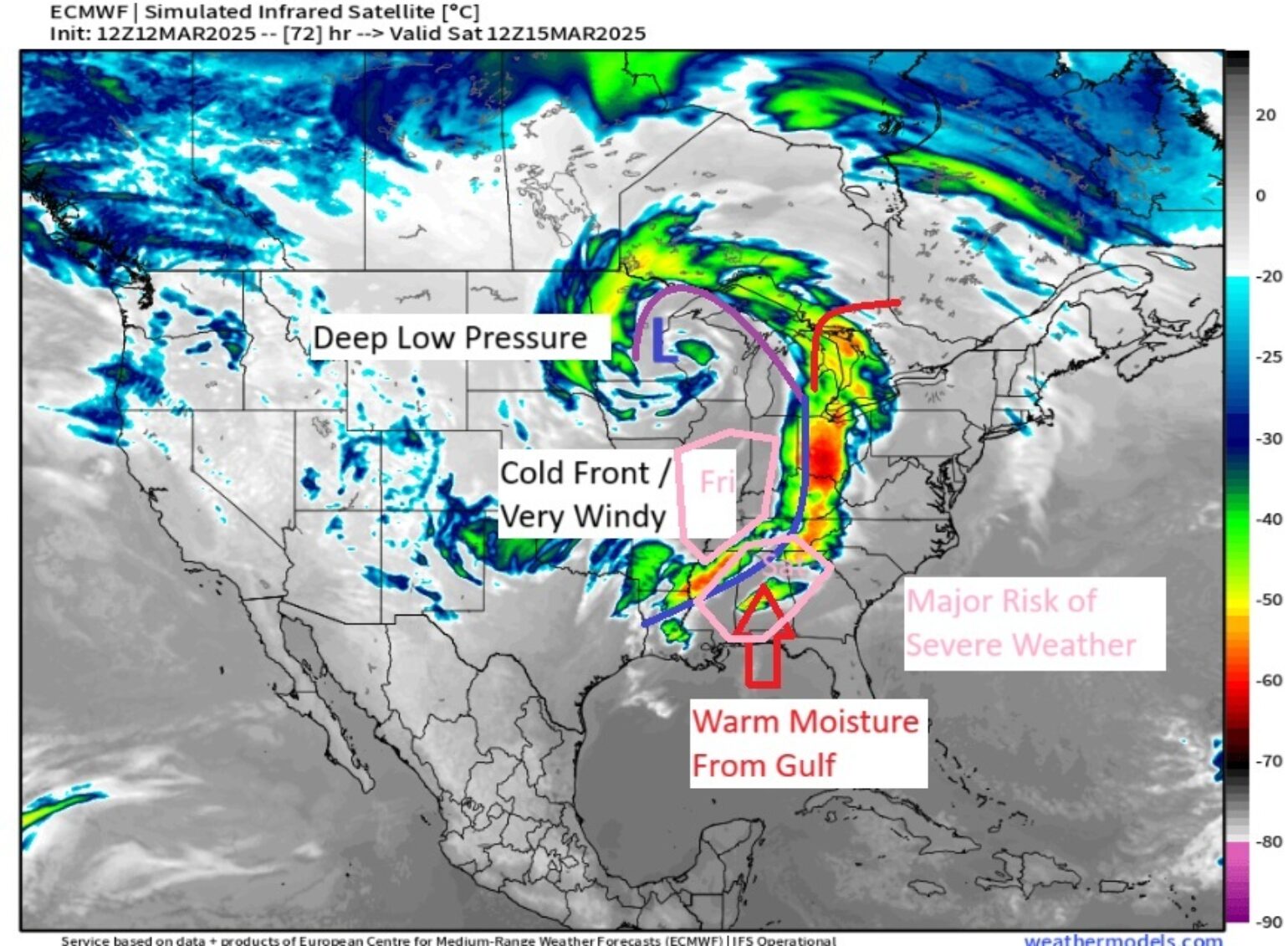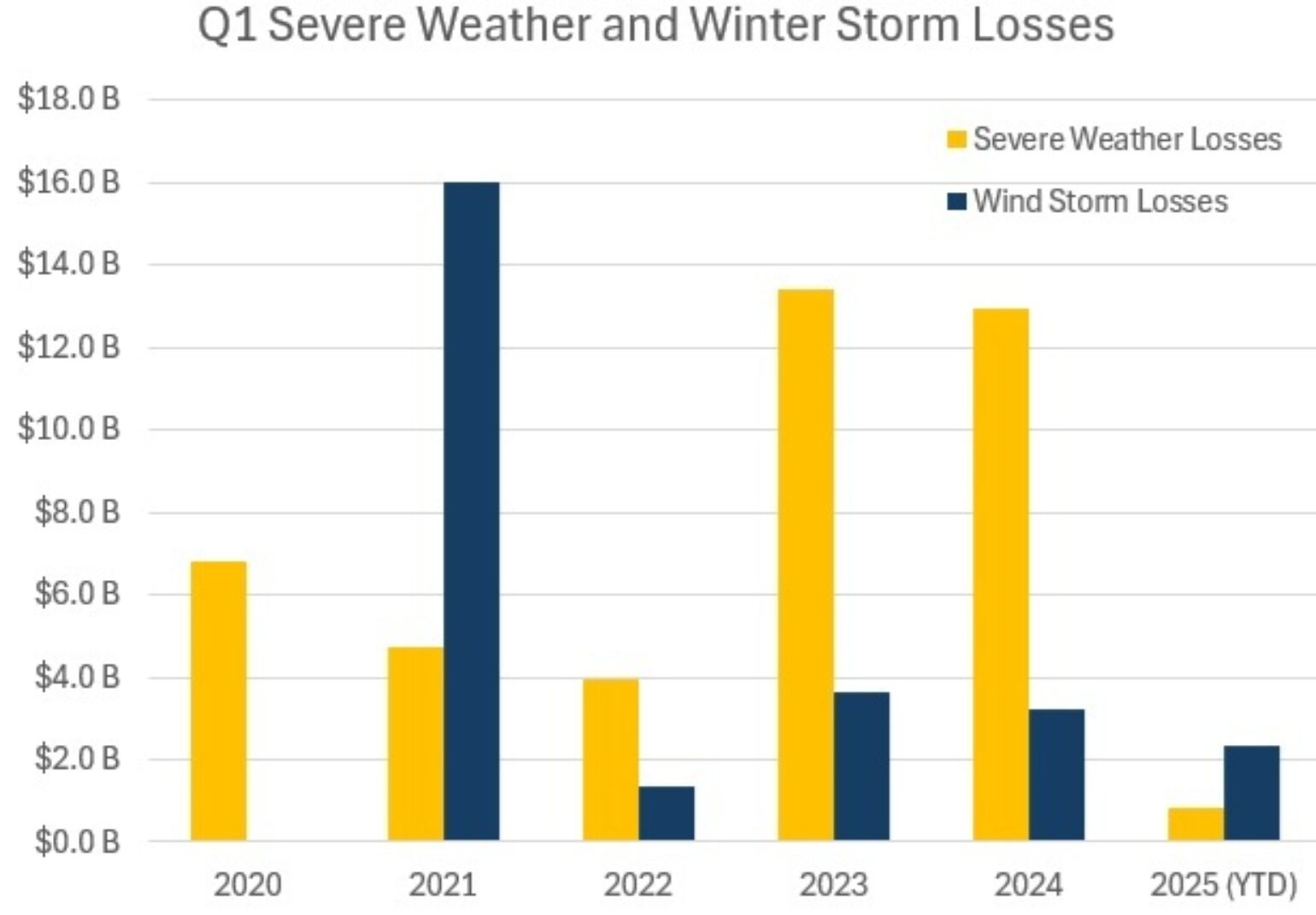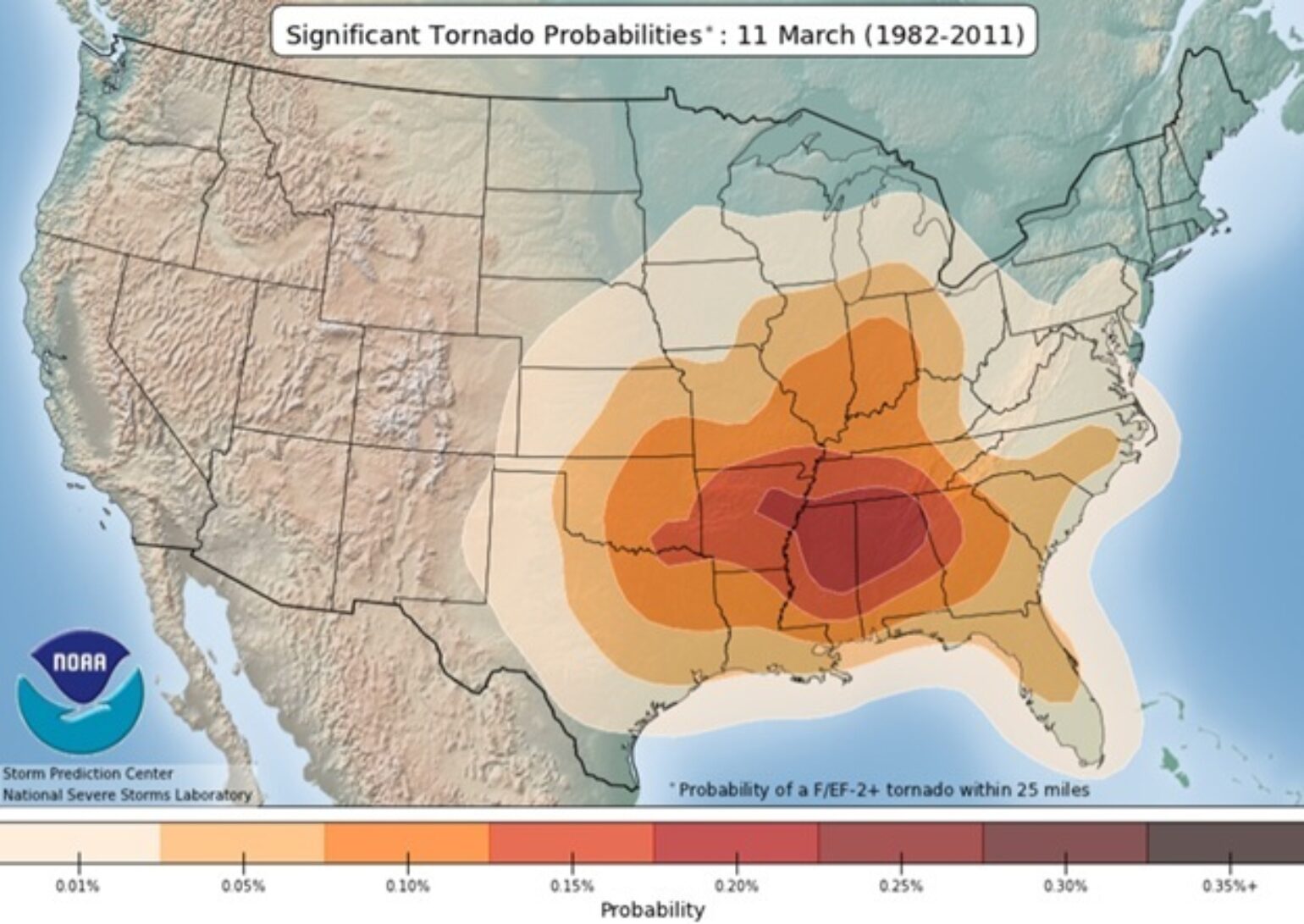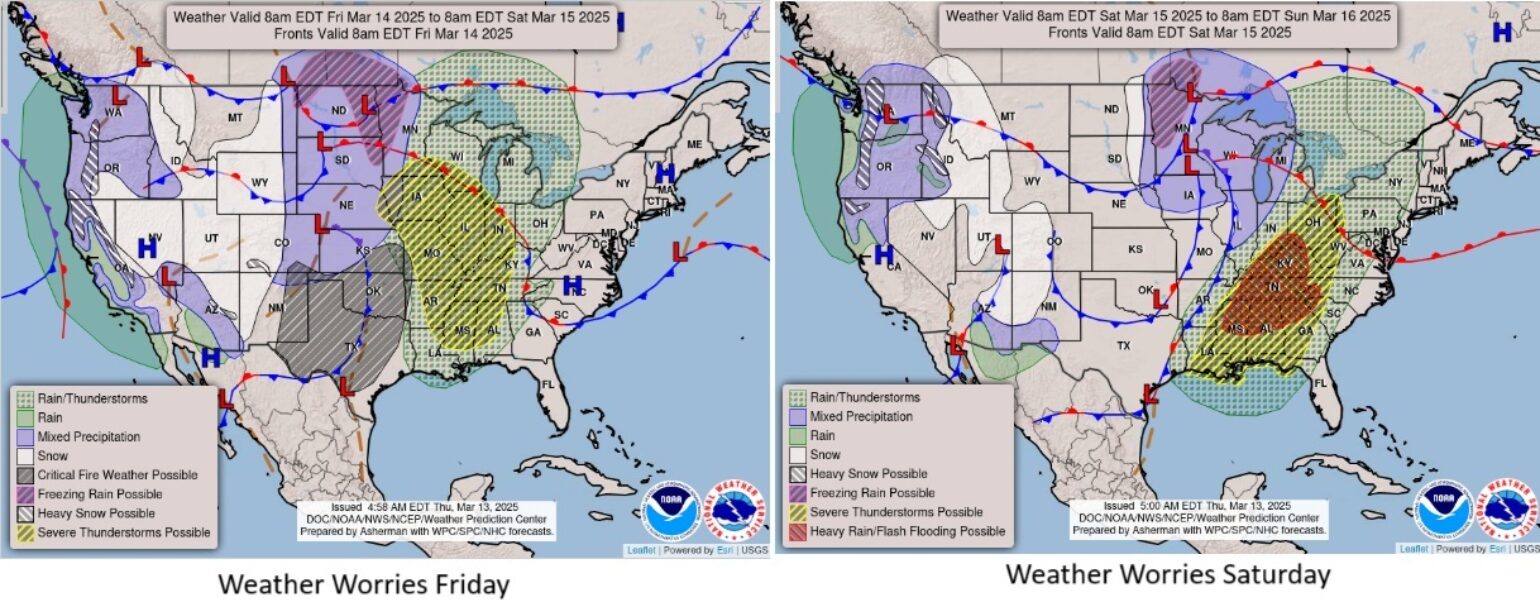BMS Severe Weather Update 3/13/2025
Buckle up… Friday (3/14) and Saturday (3/15), the stage is set to be very active regarding severe weather and impacts to the insurance industry. Tornadoes (some strong), damaging winds and hail, and enhanced wildfire risk along the East Coast and Texas could all occur. This results from yet another powerful low-pressure system that will bring record-breaking low air pressure to parts of the Central Plains of Kansas up into Minnesota for March.

The area of severe weather will be focused on the same area where the season's first severe weather outbreak swept across the southern states from Texas to parts of the Mid-Atlantic from March 3rd– 6th, producing the largest severe weather outbreak of the season, with a total of 569 severe weather reports. While it is too early to determine the exact losses from this recent severe weather outbreak, its impacts would likely surpass a half-a-billion-dollar event. This week's forecasted event will likely have similar impacts and highlight that the insurance industry is facing challenges as severe convective storms are becoming more costly.
Severe Weather Loss Trends
With much of the insurance industry's attention turned towards the large LA wildfire losses at the start of the year, which is about one-third of the 2024 total insurance losses. Some in the insurance industry might be surprised that so far, for 2025, the severe weather season has been quiet. This past week's severe weather outbreak was the first of the season to cause widespread insurance industry loss east of the Rockies in 2025, which is unusual. Outside of the large wildfire losses so far for the first quarter, much of the losses have been a result of 8 different winter storm events that have contributed towards more than $2B in insurance industry losses so far in 2025, However with only one major severe weather outbreak this year, winter storm and severe weather losses are running about 27% of the losses experienced over the last 5 years which have average $13B in the first quarter since 2020. With half the month over, the insurance industry should expect about three more severe weather loss events, given the long-range forecast. Of course, it will depend on the severity of these outbreaks and the magnitude of the overall impacts on how this first quarter ends up for the insurance industry. Still, severe weather losses have been behind the five-year average, at least for now.

While overall, there has been a string of named storm landfalls for the insurance industry over the last 5 years, which have resulted in some significant losses, not so quietly, total severe thunderstorm losses far exceed the losses from named storms by over $50B and over $100B from U.S. severe weather losses in just the last two years. So, this not-so-secondary peril of severe thunderstorms continues to be a significant focus for the insurance industry, with carriers looking to raise rates, change up policy wordings, provide higher deductible options for policyholders, and implement innovative insurtech solutions on the underwriting and claims side to limit losses.
Last year, the Storm Prediction Center issued more than 1,900 preliminary tornado local storm reports, more than the very active year of 2011 and possibly the most ever. With all the focus on tornadoes which can be very damaging to homes, we can’t forget most of the insurance problems stem from hail, which is the leading loss-driver, accounting for 50-80% of the damage from severe storms in the U.S. each year according to the Insurance Institute for Business & Home Safety (IBHS).
Severe Weather Outlook
As highlighted above, this year thus far, severe weather outbreaks have been hard to come by, but between last week's outbreak and this week's outbreak, there has clearly been a shift to a more progressive weather pattern that allows for the development of severe weather. Climatologically, March can have some of the largest and most costly outbreaks of severe weather. In fact, next week, on March 18th, it will be the 100-year anniversary of the infamous Tri-State tornado that occurred in 1925. Considering a range of methods, it would be safe to say that today, this outbreak of tornado losses alone would cost approximately $2.8B+, given the development of both rural and urban areas along many of the tornado paths.
The severe weather forecasted for the remainder of this week is occurring right where it should based, on climatology, which is along what is called Dixie Alley.

There will be some severe weather today across parts of eastern Mississippi into Alabama, western Georgia, and parts of the Florida Panhandle. However, the main event looks like it will occur on Friday, 3/14, into Saturday, 3/15. The impact of severe weather on Friday highly depends on how much moisture can make it further north into the warm sector of the low that is developing in the Central Plains. Indications at this time are that Gulf moisture reaching far north into the warm sector will be limited Friday, thus leaving just a significant wind risk further north into parts of Eastern Missouri and Illinois and the lower Ohio River Valley. Any significant tornado risk on Friday will likely be contained to Arkansas and Tennessee, though it depends on moisture transport from the Gulf. The Storm Prediction Center has issued a 4 out of 5 Moderate risk. Saturday, 3/15, looks to be the day in which the atmosphere will have a better connection to Gulf moisture, bringing a more significant tornado risk. The overall environment suggested a much more favorable environment for tornado formation in Dixie Alley, with very high CAPE and wind shear, which are prime ingredients for tornadoes. Some recent analog events here look to be 4/12/2020 and 3/22/2022, both of which had 50+ tornadoes reported, and both resulted in billion-dollar-plus loss events for the insurance industry. In fact, according to the SPC, the Day 3 Convective Outlook also has a day 4 out of 5 Moderate risk, which could be pushed to a High Risk in the coming day, but a day 3 moderate risk is statistically rare, with only 18 such events since 2005.

Finally, the risk of severe weather is apparent across the Mid-Atlantic for Sunday, March 15. This risk will likely be highly dependent on daytime heating. We could be looking at similar severe weather on 3/6 last week.
A quick look ahead for the next 10 days shows the parade of high amplitude troughs in a progressive pattern from the North Pacific across the Lower 48 into the Atlantic, much like we have seen over the last week with the recent severe weather. Looking ahead, of course, we can expect more severe weather in the months ahead. Will it top last year's record tornado count? I don’t think so. El Niño/Southern Oscillation (ENSO) is one of the best oceanic teleconnections for forecasting long-range severe weather. ENSO is the warming and cooling of a body of water in the Central Pacific. The ENSO phase is transitioning out of a very weak La Niña (cooler waters)-like phase to neutral phase this year. Historically, when this happens, it yields higher probabilities of a tornado outbreak occurring in the Central Mississippi River Valley and Ohio River Valley into the southeast, which could see higher than regular severe weather activity with more normal activity across the Central Plains states.
So buckle up. The next few days are set to bring a barrage of weather events that could trigger significant losses for the insurance industry. While severe weather takes center stage, the powerful storm system may also spark wildfires across the Central Plains and parts of the East Coast, prompting Red Flag warnings. Meanwhile, the intense low-pressure system will fuel a robust winter storm in parts of the upper Midwest, bringing powerful winds and snow.
